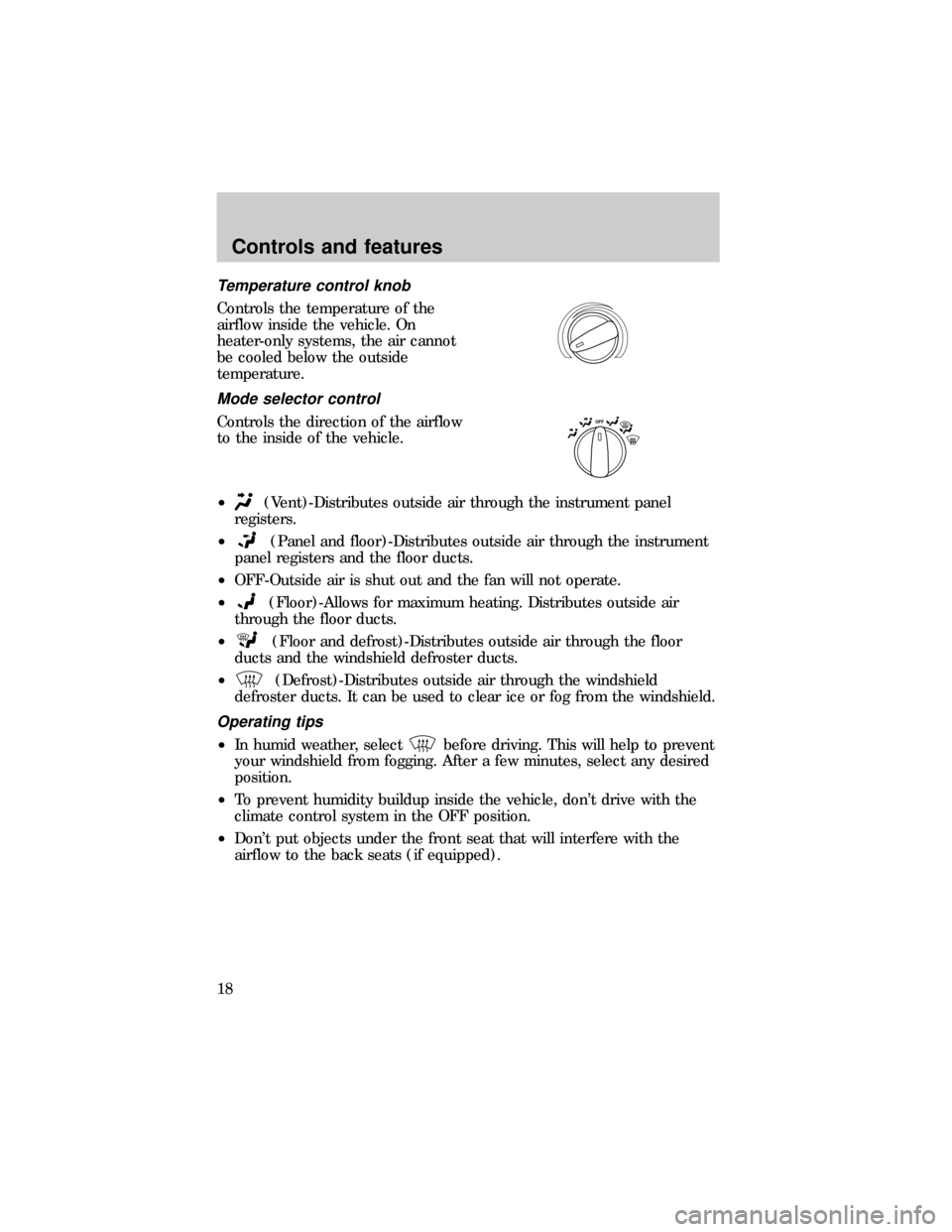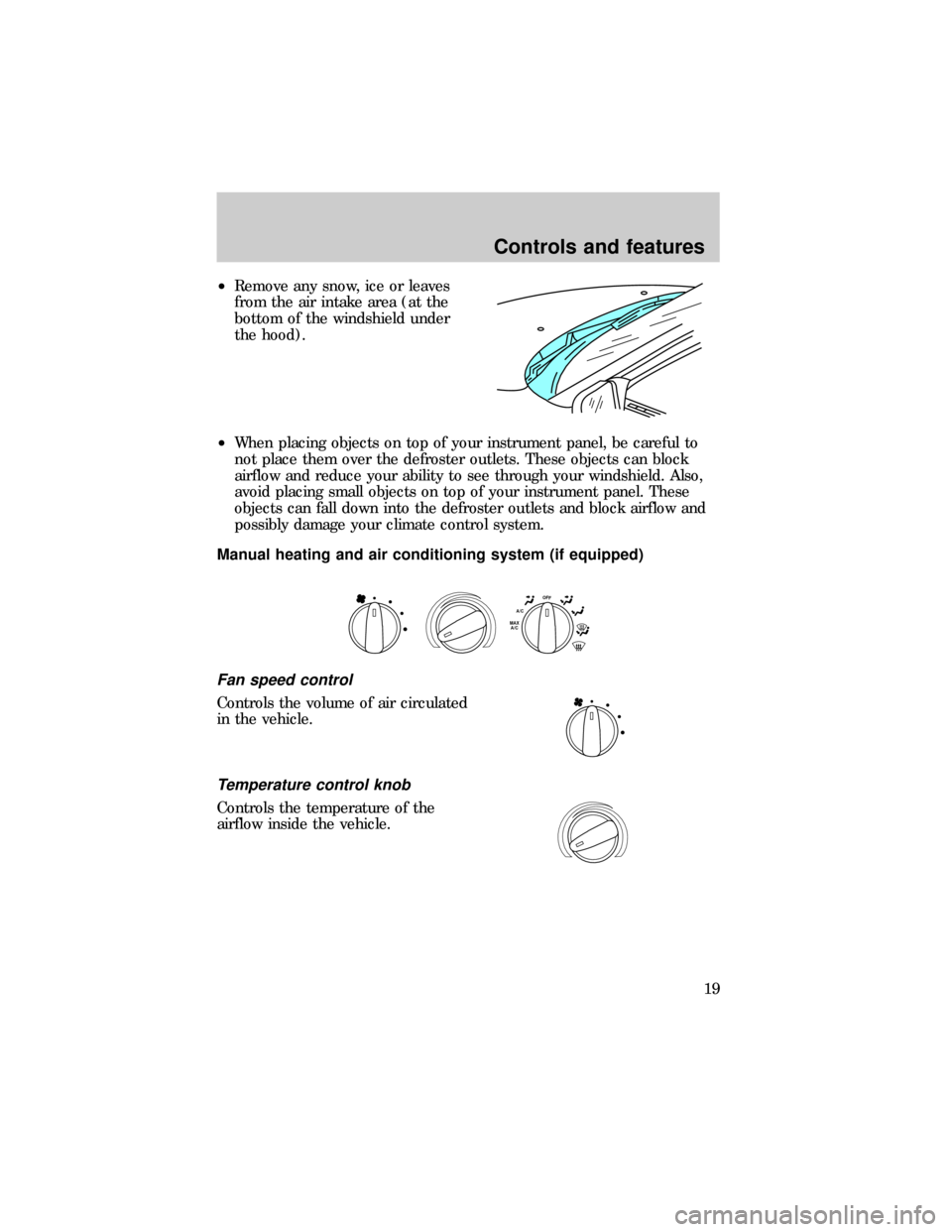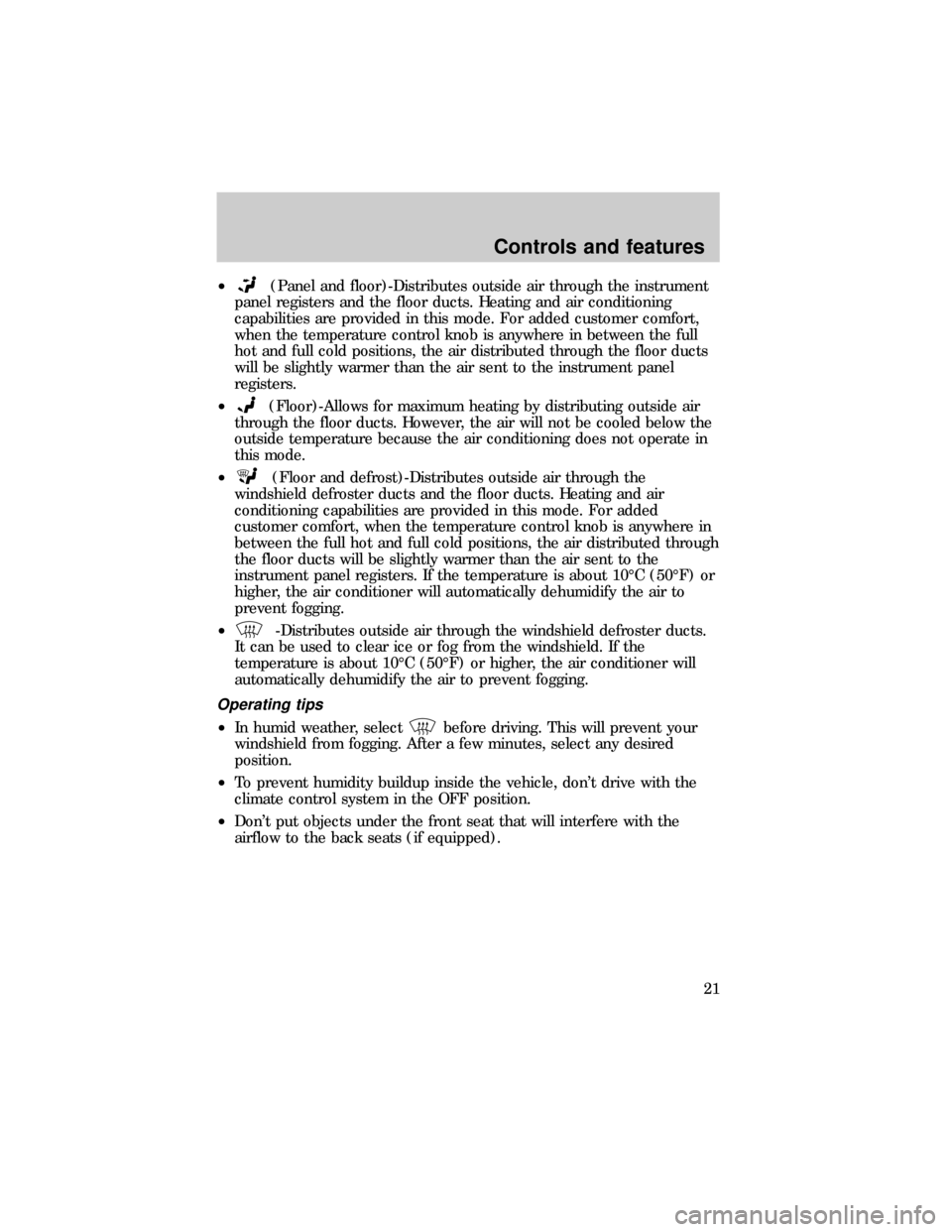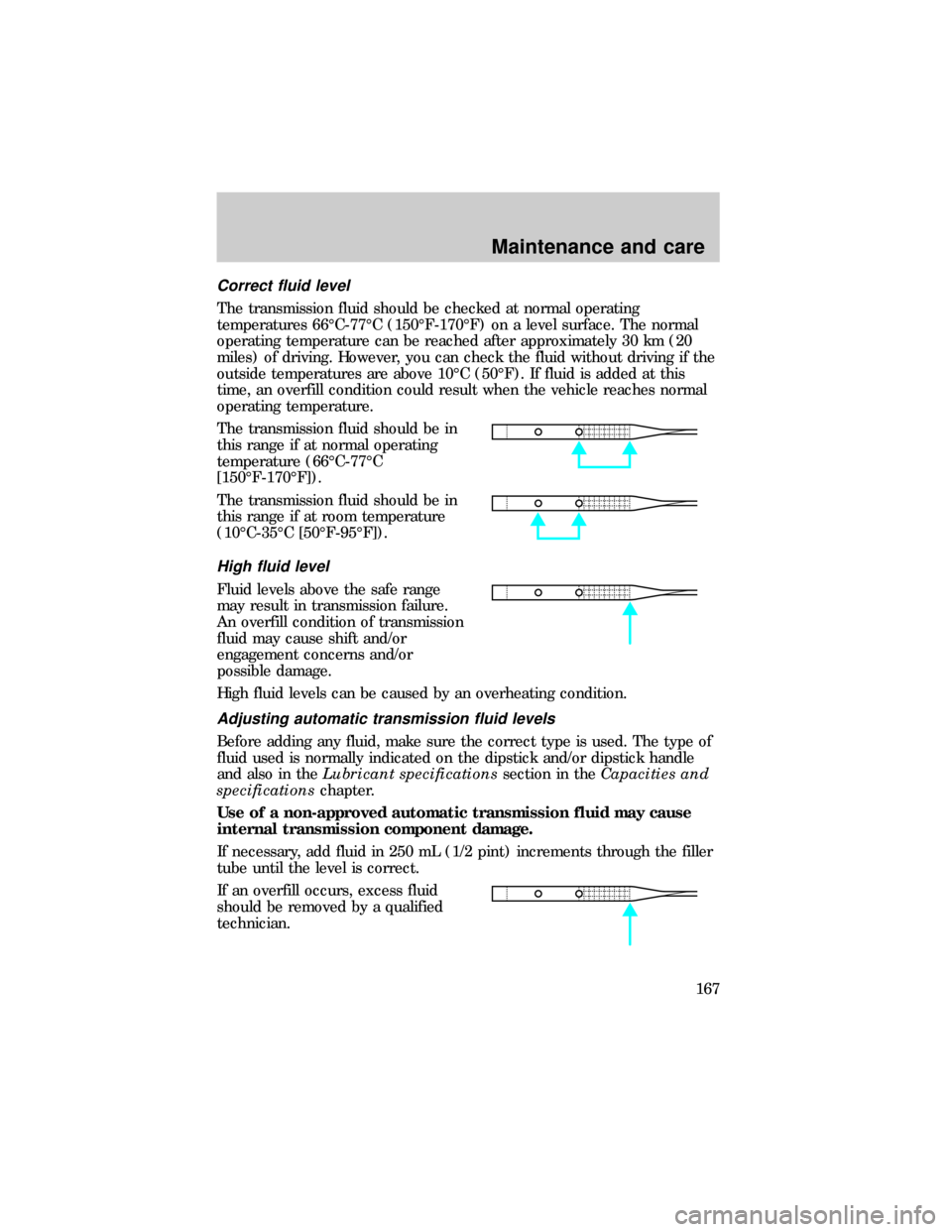1999 FORD RANGER heating
[x] Cancel search: heatingPage 13 of 216

Engine coolant temperature gauge
Indicates the temperature of the
engine coolant. At normal operating
temperature, the needle remains
within the normal area (the area
between the ªHº and ªCº). If it
enters the red section, the engine is
overheating. Stop the vehicle as
soon as safely possible, switch off
the engine immediately and let the
engine cool. Refer toEngine
coolantin theMaintenance and
carechapter.
Never remove the coolant reservoir cap while the engine is
running or hot.
This gauge indicates the temperature of the engine coolant, not the
coolant level. If the coolant is not at its proper level the gauge indication
will not be accurate.
Tachometer (if equipped)
Indicates the engine speed in
revolutions per minute.
Driving with your tachometer
pointer continuously at the top of
the scale may damage the engine.
C
H
0 12345
6
RPMx1000
Instrumentation
13
Page 18 of 216

Temperature control knob
Controls the temperature of the
airflow inside the vehicle. On
heater-only systems, the air cannot
be cooled below the outside
temperature.
Mode selector control
Controls the direction of the airflow
to the inside of the vehicle.
²
(Vent)-Distributes outside air through the instrument panel
registers.
²
(Panel and floor)-Distributes outside air through the instrument
panel registers and the floor ducts.
²OFF-Outside air is shut out and the fan will not operate.
²
(Floor)-Allows for maximum heating. Distributes outside air
through the floor ducts.
²
(Floor and defrost)-Distributes outside air through the floor
ducts and the windshield defroster ducts.
²
(Defrost)-Distributes outside air through the windshield
defroster ducts. It can be used to clear ice or fog from the windshield.
Operating tips
²In humid weather, selectbefore driving. This will help to prevent
your windshield from fogging. After a few minutes, select any desired
position.
²To prevent humidity buildup inside the vehicle, don't drive with the
climate control system in the OFF position.
²Don't put objects under the front seat that will interfere with the
airflow to the back seats (if equipped).
OFF
Controls and features
18
Page 19 of 216

²Remove any snow, ice or leaves
from the air intake area (at the
bottom of the windshield under
the hood).
²When placing objects on top of your instrument panel, be careful to
not place them over the defroster outlets. These objects can block
airflow and reduce your ability to see through your windshield. Also,
avoid placing small objects on top of your instrument panel. These
objects can fall down into the defroster outlets and block airflow and
possibly damage your climate control system.
Manual heating and air conditioning system (if equipped)
Fan speed control
Controls the volume of air circulated
in the vehicle.
Temperature control knob
Controls the temperature of the
airflow inside the vehicle.
OFFA/CMAX
A/C
Controls and features
19
Page 21 of 216

²(Panel and floor)-Distributes outside air through the instrument
panel registers and the floor ducts. Heating and air conditioning
capabilities are provided in this mode. For added customer comfort,
when the temperature control knob is anywhere in between the full
hot and full cold positions, the air distributed through the floor ducts
will be slightly warmer than the air sent to the instrument panel
registers.
²
(Floor)-Allows for maximum heating by distributing outside air
through the floor ducts. However, the air will not be cooled below the
outside temperature because the air conditioning does not operate in
this mode.
²
(Floor and defrost)-Distributes outside air through the
windshield defroster ducts and the floor ducts. Heating and air
conditioning capabilities are provided in this mode. For added
customer comfort, when the temperature control knob is anywhere in
between the full hot and full cold positions, the air distributed through
the floor ducts will be slightly warmer than the air sent to the
instrument panel registers. If the temperature is about 10ÉC (50ÉF) or
higher, the air conditioner will automatically dehumidify the air to
prevent fogging.
²
-Distributes outside air through the windshield defroster ducts.
It can be used to clear ice or fog from the windshield. If the
temperature is about 10ÉC (50ÉF) or higher, the air conditioner will
automatically dehumidify the air to prevent fogging.
Operating tips
²In humid weather, selectbefore driving. This will prevent your
windshield from fogging. After a few minutes, select any desired
position.
²To prevent humidity buildup inside the vehicle, don't drive with the
climate control system in the OFF position.
²Don't put objects under the front seat that will interfere with the
airflow to the back seats (if equipped).
Controls and features
21
Page 102 of 216

Guarding against exhaust fumes
Although odorless and colorless, carbon monoxide is present in exhaust
fumes. Take precautions to avoid its dangerous effects.
If you ever smell exhaust fumes of any kind inside your vehicle,
have your dealer inspect and fix your vehicle immediately. Do
not drive if you smell exhaust fumes. These fumes are harmful and
could kill you.
Have the exhaust and body ventilation systems checked whenever:
²the vehicle is raised for service.
²the sound of the exhaust system changes.
²the vehicle has been damaged in a collision.
Engine exhaust, some of its constituents, and certain vehicle
components contain or emit chemicals known to the State of
California to cause cancer, and birth defects or other reproductive
harm.
Important ventilating information
If the engine is idling while the vehicle is stopped in an open area for
long periods of time, open the windows at least 2.5 cm (one inch).
Adjust the heating or air conditioning (if equipped) to bring in fresh air.
Improve vehicle ventilation by
keeping all air inlet vents clear of
snow, leaves and other debris.
Starting
102
Page 167 of 216

Correct fluid level
The transmission fluid should be checked at normal operating
temperatures 66ÉC-77ÉC (150ÉF-170ÉF) on a level surface. The normal
operating temperature can be reached after approximately 30 km (20
miles) of driving. However, you can check the fluid without driving if the
outside temperatures are above 10ÉC (50ÉF). If fluid is added at this
time, an overfill condition could result when the vehicle reaches normal
operating temperature.
The transmission fluid should be in
this range if at normal operating
temperature (66ÉC-77ÉC
[150ÉF-170ÉF]).
The transmission fluid should be in
this range if at room temperature
(10ÉC-35ÉC [50ÉF-95ÉF]).
High fluid level
Fluid levels above the safe range
may result in transmission failure.
An overfill condition of transmission
fluid may cause shift and/or
engagement concerns and/or
possible damage.
High fluid levels can be caused by an overheating condition.
Adjusting automatic transmission fluid levels
Before adding any fluid, make sure the correct type is used. The type of
fluid used is normally indicated on the dipstick and/or dipstick handle
and also in theLubricant specificationssection in theCapacities and
specificationschapter.
Use of a non-approved automatic transmission fluid may cause
internal transmission component damage.
If necessary, add fluid in 250 mL (1/2 pint) increments through the filler
tube until the level is correct.
If an overfill occurs, excess fluid
should be removed by a qualified
technician.
Maintenance and care
167
Page 210 of 216

Air bag supplemental restraint
system ..........................................81
and child safety seats ..............83
description ................................82
disposal ......................................85
indicator light ...........................85
passenger air bag .....................83
passenger deactivation
switch ....................23,86,87,88,89
Air conditioning
manual heating and air
conditioning system .......19,20,21
Automatic transmission
driving an automatic
overdrive .....108,109,110,111,112
Axle
refill capacities ........................200
Battery
voltage gauge ............................15
Brakes ........................................103
anti-lock .....................103,104,105
anti-lock brake system (ABS)
warning light ...........................104
fluid, checking and adding ....160
shift interlock ..........................107
Break-in period ..........................2,3
Cargo area shade ........................64
Cargo net .....................................64
CD player ....................................51
Child safety seats
attaching with tether straps ....96
in rear seat ................................93
tether anchorage hardware .....96
Cleaning your vehicle ...............195
engine compartment ..............196
exterior .............................196,199
exterior lamps .........................198
interior .....................................199
plastic parts ............................198
washing ....................................195
waxing .....................................195
wheels ......................................196windows ..................................199
wiper blades ............................198
Clutch
fluid ..........................................161
operation while driving ...112,113
recommended shift speeds ....114
Console ........................................64
Coolant ...............................164,165
checking and adding ..............163
refill capacities ........................165
Driveline universal joint and
slip yoke ....................................169
Driving under special
conditions ...........................118,119
sand .........................................119
snow and ice ...........................120
through water .........................119
Emission control system ..........186
Engine
check engine/service engine
soon light .................................6,7
coolant .....................................162
idle speed control ...................170
service points ............154,155,156
starting after a collision .........133
Engine block heater .................100
Engine oil
checking and adding ..............158
dipstick ....................................157
specifications ...................157,159
Exhaust fumes ..........................102
Four-Wheel Drive vehicles ..10,115
description .......................116,117
driving off road .......................118
electronic shift ..............22,23,116
indicator light .........................115
Fuel
choosing the right fuel ...........180
comparisons with EPA fuel
economy estimates .................186
detergent in fuel .....................182
Index
210
Page 211 of 216

filling your vehicle
with fuel ...........................178,180
gauge .........................................12
quality ......................................182
running out of fuel .................183
safety information relating to
automotive fuels .....................178
Fuses ...................................134,135
Gas mileage (see Fuel
economy) ..............183,184,185,186
Gauges ....................................11,12
engine coolant temperature
gauge .........................................13
engine oil pressure gauge ........15
GVWR
(Gross Vehicle Weight Rating)
calculating ..........123,128,129,130
Hazard flashers .........................133
Headlamps
aiming ......................................194
bulb specifications ..................194
high beam ..............................9,16
warning chime ..........................11
Heating ........................................17
heater only system ..............17,18
Hood ..........................................153
Ignition .......................................204
Inspection/maintenance
(I/M) testing ..............................188
Instrument panel ..........................6
cleaning ...................................198
Keys
key in ignition chime ...............11
positions of the ignition ...........55
Lamps
daytime running light ...............16
fog lamps ...................................16
headlamps .................................16
headlamps, flash to pass ..........17
instrument panel, dimming .....17
interior lamps .........................194replacing
bulbs .....188,189,190,191,192,193
Lane change indicator (see
Turn signal) .................................55
Lights, warning and indicator
air bag ..........................................8
anti-lock brakes (ABS) ..............9
anti-theft .....................................9
brake ............................................8
charging system ..........................9
check coolant ............................10
cruise indicator .........................11
door ajar ....................................10
fuel reset .....................................8
overdrive off ..............................10
safety belt ...................................8
speed control ............................60
turn signal indicator ...................9
Lumbar support, seats ..........72,73
Manual transmission
reverse .....................................114
Mirrors
cleaning ...................................199
side view mirrors (power) .......63
Motorcraft parts ........................183
Octane rating ............................181
Odometer .....................................14
Overdrive .....................................60
Panic alarm feature, remote
entry system ................................65
Parking brake ............................105
Power distribution box
(see Fuses) ...............................138
Power door locks ........................63
Power steering ..........................106
fluid, checking and adding ....165
Radio ...24,25,26,27,28,29,30,31,32,
33,34,35,36,37,38,39,41,
42,43,44,45,46,47,48,49,51
Relays ........................................134
Remote entry system ..64,68,69,70
illuminated entry ......................67
Index
211